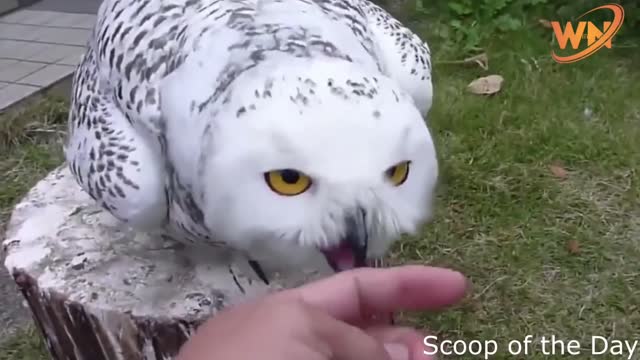Premium Only Content

animals 4k - the snowy owl 😱
animals 4k - the snowy oy 😱
The snowy owl (Bubo scandiacus), also known as the polar owl, the white owl and the Arctic owl,[4] is a large, white, owl of the true owl family.[5] Snowy owls are native to the Arctic regions of both North America and the Palearctic, breeding mostly on the tundra.[2] It has a number of unique adaptations to its habitat and lifestyle, which are quite distinct from other extant owls.[6] One of the largest species of owl, it is the only owl with largely white plumage.[5] Males tend to be a purer white overall while females tend to more have more extensive flecks of dark brown.[7] Juvenile male snowy owls have dark markings that may appear similar to females until maturity, at which point they typically turn whiter. The composition of brown markings about the wing, although not foolproof, is the most reliable technique to age and sex individual snowy owls.
Most owls sleep during the day and hunt at night, but the snowy owl is often active during the day, especially in the summertime.[6] The snowy owl is both a specialized and generalist hunter. Its breeding efforts and entirely global population are closely tied to the availability of tundra-dwelling lemmings but in the non-breeding season and occasionally during breeding the snowy owl can adapt to almost any available prey, most often other small mammals and northerly water birds (as well as, opportunistically, carrion).[4][7] Snowy owls typically nest on a small rise on the ground of the tundra.[9] The snowy owl lays a very large clutch of eggs, often from about 5 to 11, with the laying and hatching of eggs considerably staggered.[7] Despite the short Arctic summer, the development of the young takes a relatively long time and independence is sought in autumn.[6]
The snowy owl is a nomadic bird, rarely breeding at the same locations or with the same mates on an annual basis and often not breeding at all if prey is unavailable.[7] A largely migratory bird, snowy owls can wander almost anywhere close to the Arctic, sometimes unpredictably irrupting to the south in large numbers.[7][10] Given the difficulty of surveying such an unpredictable bird, there was little in depth knowledge historically about the snowy owl's status. However, recent data suggests the species is declining precipitously.[2][11] Whereas the global population was once estimated at over 200,000 individuals, recent data suggests that there are probably fewer than 100,000 individuals globally and that the number of successful breeding pairs is 28,000 or even considerably less.[2][12] While the causes are not well-understood, numerous, complex environment factors often correlated with global warming are probably at the forefront of the fragility of the snowy owl's existence.
The snowy owl is mostly white. They are purer white than predatory mammals like polar bears (Ursus maritimus) and Arctic fox (Vulpes lagopus).[9] Often when seen in the field, these owls can resemble a pale rock or a lump of snow on the ground.[9] It usually appears to lack ear tufts but very short (and probably vestigial) tufts can be erected in some situations, perhaps most frequently by the female when she is sitting on the nest.[5] The ear tufts measure about 20 to 25 mm (0.79 to 0.98 in) and consist of about 10 small feathers.[6] The snowy owl has bright yellow eyes.[7] The head is relatively small and, even for the relatively simply adapted hearing mechanism of a Bubo owl, the facial disc is shallow and the ear is uncomplicated.[5][6] 1 male had ear slits of merely 21 mm × 14 mm (0.83 in × 0.55 in) on left and 21 mm × 14.5 mm (0.83 in × 0.57 in) on the right.[6] Females are almost invariably more duskily patterned than like-age males.[5][7] In mature males, the upper parts are plain white with usually a few dark spots on the miniature ear-tufts, about the head and the tips of some primaries and secondaries whilst the underside is often pure white.[5] Despite their reputation for being purely white, only 3 out of 129 Russian museum specimens of adult males showed an almost complete absence of darker spots. The adult female is usually considerably more spotted and often slightly barred with dark brown on the crown and the underparts. Her flight and tail feathers are faintly barred brown while the underparts are white in base color with brown spotting and barring on the flanks and upper breast.[5] In confusingly plumaged snowy owls, the sex can be determined by the shape of wing markings, which manifest as bars more so in females and spots in males.[4][34] However, the very darkest males and the lightest females are nearly indistinguishable by plumage.[4] On rare occasion, a female can appear almost pure white, as has been recorded in both the field and in captivity.[35] There is some evidence that some of the species grow paler with age after maturity.[7][36] One study's conclusions were that males were usually but not always lighter and that correctly aging is extremely difficult, sometimes individuals either get lighter, darker or do not change their appearance with age.[35] On the other hand, with close study, it is possible to visually identify even individual snowy owls using the pattern of markings on the wing, which can be somewhat unique in each individual.[37] After a fresh moult, some adult females that previously appeared relatively pale newly evidenced dark, heavy markings. On the contrary, some banded individuals over at least four years were observed to have been almost entirely unchanged in the extent of their markings.[4][7] In another very pale owl, the barn owl (Tyto alba), the sexual dimorphism of spotting appears to be driven by genetics while, in snowy owls, environment may be the dictating factor instead.
#snowyowl #owl #owls #birds #owlstagram #owllover #owleyes #owlphotography #owlsofinstagram #owlstuff #bird #birdsofprey #feature #lovers #owllovers #owlobsession #owly #greathornedowl #owlseverywhere #owldrawing #owlsanctuary #owlcafe #owlart #owlet #nature #owlfanworld #owlsome #owlpendant #whiteowl #wildlife
#owlcup #elite #iloveowls #owlcoffee #owllove #buboscandiacus #barnowl #owladdict #snowowl #barredowl #birdsofinstagram #uggla #littleowls #funnyowl #best #owlbag #whitefacedscopsowl #owlcookies #littlebird #ugglor #barredowls #hegwig #burowingowls #owlsaddicted #owlsnest #wildlifephotography #of #owlearrings #birdwatching #raptors
-
 34:12
34:12
inspirePlay
1 day ago $5.73 earned🏆 The Grid Championship 2024 – Cass Meyer vs. Kelly Rudney | Epic Battle for Long Drive Glory!
89.9K8 -
 17:50
17:50
BlackDiamondGunsandGear
16 hours ago $3.11 earnedTeach Me How to Build an AR-15
63.9K6 -
 9:11
9:11
Space Ice
1 day agoFatman - Greatest Santa Claus Fighting Hitmen Movie Of Mel Gibson's Career - Best Movie Ever
121K48 -
 42:38
42:38
Brewzle
1 day agoI Spent Too Much Money Bourbon Hunting In Kentucky
82.2K13 -
 1:15:30
1:15:30
World Nomac
1 day agoMY FIRST DAY BACK in Manila Philippines 🇵🇭
63.9K10 -
 13:19
13:19
Dr David Jockers
1 day ago $11.93 earned5 Dangerous Food Ingredients That Drive Inflammation
82.5K17 -
 1:05:13
1:05:13
FamilyFriendlyGaming
1 day ago $15.97 earnedCat Quest III Episode 8
132K3 -
 10:39
10:39
Cooking with Gruel
2 days agoMastering a Succulent London Broil
84.6K5 -
 22:15
22:15
barstoolsports
1 day agoWhite Elephant Sends Barstool Office into Chaos | VIVA TV
59.7K1 -
 3:30:40
3:30:40
MrNellyGB
22 hours ago🔴LIVE - GRINDING MARVEL RIVALS RANKED! | #RumbleTakeover #RumblePremium
41.1K1